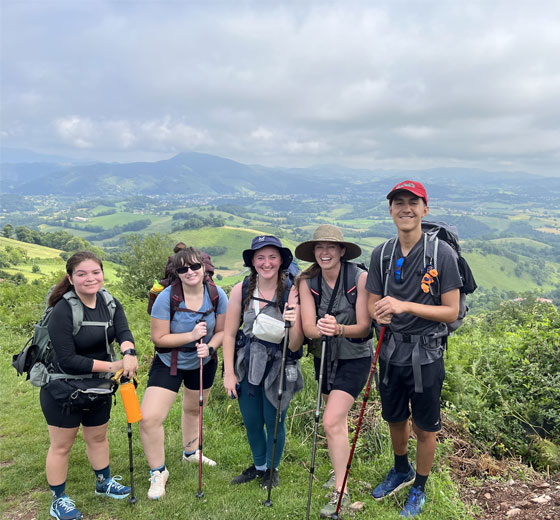Posted on August 24, 2023 by Nathan Richardson

Students on El Camino at the top of a hill
(August 25, 2023) This summer five UTSA students spent their summer walking across Spain. Battling heat, blisters, and bad knees, Bella Degarmo (Political Science and Modern Languages), Jaclyn Lerma (Physics and Astronomy), Ashlie Newman (Art), George Salazar (Cybersecurity), and Alana Schwartz (Anthropology) are following step by step in the path of a thousand years-worth of pilgrims to the historic city of Santiago de Compostela.
There, over a thousand years ago, the body of St. James was discovered. Almost immediately pilgrims from across Europe began walking to Santiago to pray and pay homage. Today the route they created is known to walkers around the world as simply "The Camino." This year around 300,000 pilgrims are projected to complete the journey. Most of them, however, will walk as little as 100 kilometers. The five UTSA students chose, instead, to walk the historic "Camino Frances," an 800-kilometer path beginning in southern France, traversing the Pyrenees, and then crossing through territories that once were part of four different medieval Spanish kingdoms.
The journey is part of a class on The Camino, taught by Nathan Richardson, UTSA Professor of Spanish, Associate Dean of Undergraduate Studies at COLFA, and a Camino veteran, who also led the journey.
"The Camino is a culmination of culture, nature, and suffering where you're forced to connect with people on a level you never knew was possible," stated Alana Schwartz.
The UTSA students often spend six or seven hours a day walking and inevitably conversing with people from all over the world. Favorite Camino amigos included new friends from Australia, the Netherlands, Scotland, Mexico, and of course plenty of other Americans. Reflecting on the medieval nature of the journey, Jaclyn Lerma added, "I am experiencing the world in a whole different way, the way people way back when did--through all the triumphs and all the tribulation."
Students traveled to Santiago for a brief reprieve before continuing on to the cliffs known in the medieval world as Finisterre, or the “the end of the earth”. After a quick dip in the Atlantic, the students made their return home to San Antonio where they earned a long sleep in their own beds.
Reflecting on the journey after returning to UTSA, Richardson says, “I couldn’t be prouder of what the students accomplished over the course of a month, foisting a heavy pack on their back day after day, battling heat and hail and really rough terrain. Some of the students had blisters and knee problems that never went away. But through it all, they just kept pushing, kept walking, one step at a time, and through the process experienced history firsthand and made friendships from around the world that will last a lifetime.”
Based on feedback, Richardson is thinking about taking students on another Camino a couple of years from now. But, he says, only if they’re as tough as this first group.
If you think you’ve got what it takes, Richardson recommends you check out his course titled “The Art and Politics of Wandering,” or just drop him an email. He’s always looking for new Camino friends.
Explore Further
- Learn more about how you can develop new language skills through the Department of Modern Languages & Literatures
- Learn more about Nathan Richardson

